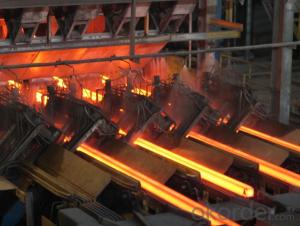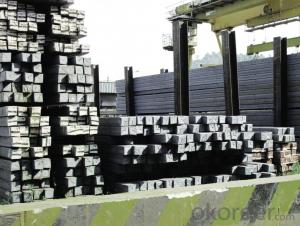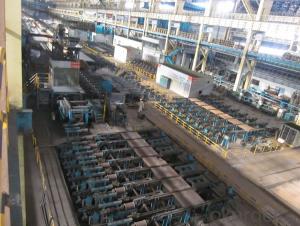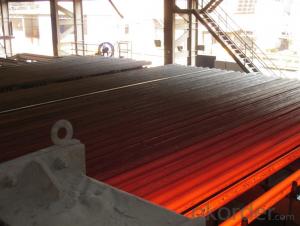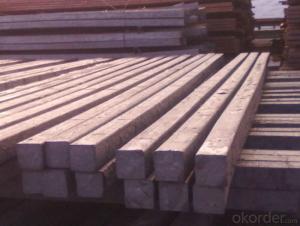Prime Q275 105mm Square Alloy Steel Billet
- Loading Port:
- Shanghai
- Payment Terms:
- TT OR LC
- Min Order Qty:
- 100 m.t.
- Supply Capability:
- 10000 m.t./month
OKorder Service Pledge
OKorder Financial Service
You Might Also Like
Structure of Prime Q275 105mm Square Alloy Steel Billet

Description of Prime Q275 105mm Square Alloy Steel Billet
1. Prepainted steel coil is coated with organic layer, which provides higher anti-corrosion property and a longer lifespan than that of galvanized or galvalume steel sheets.
2. The base metals for prepainted steel coil consist of cold rolled, HDGI Steel, electro-galvanized and hot-dip alu-zinc coated steel. The finish coats of prepainted steel coil can be classified into groups as follows: polyester, silicon modified polyesters, polyvinylidene fluoride, high-durability polyester, etc.
3. The production process has evolved from one-coating-and-one-baking to double-coating-and-double-baking, and even three-coating-and-three-baking.
4. The color of the prepainted steel coil has a very wide selection, like orange, cream-colored, dark sky blue, sea blue, bright red, brick red, ivory white, porcelain blue, etc.
5. The prepainted steel coils can also be classified into groups by their surface textures, namely regular prepainted sheets, embossed sheets and printed sheets.

Main Feature of Prime Q275 105mm Square Alloy Steel Billet
Uncoated CR steel sheet
With the features of in line with the international highest standards in demension and shape, excellent surface finish and properties, the products are mainly used in home appliance and automobile industries.
Galvanized steel sheet(include HDG and EG)
With the features of good corrosion resistance, the products are mainly used in automobile, home appliance, electronics, building and machinery manufacture industries, etc.
Precoated steel sheet
With the features of enviromental protection and good processablility, long lasting surface durability, rich in colors, the products are maily used in building, home appliance and furniture industries, etc.
Applications of Prime Q275 105mm Square Alloy Steel Billet
A. Corrugated design makes it excellent waterproof performance
B. Materials as prepainted steel sheets, galvanized steel sheets, galvalume (Al-Zn coated sheets) are available to make corrugated sheet.
C.Those material are durable, anti-corrosion in bad weather for 20-30 years based on it's Zinc(Galvanized) coating or AZ (Galvalume) coating.
D. Different shape of the sheet make it suitable for any style of buildings.
E.Easy to install, no need special tools to fix the sheet.
F.Light weight due to high strength to weight ratio of steel. Light weight means easier handling lower shipping costs, easier installation
G. Different color is availbe base on the RAL Standard make your building more beautiful.
H. We will provide the best solutions if you don't have a exact idea of the specification you want for the steel sheet based on your weather conditions, engineering structure, construction budget and so on.

Specifications of Prime Q275 105mm Square Alloy Steel Billet
Product | Billet |
Material Grade | SGCC / SGCH / DX51D+AZ, etc |
Thickness | 0.6-3.0mm |
Width | 500-1500mm |
Tolerance | Thickness: +/-0.02mm , Width:+/-2mm |
Zinc-coating | Z30-150g/m2 |
Technique | Raw material: Hot rolled steel coil --> Cold rolled_>hot dipped galvalume |
Surface | Dried, Chromated, Unoiled |
Spangle | Regular spangle , small spangle, zero spangle |
ID | 508MM 610MM |
Coil weight | 1-25MT |
Export package | Cardboard inner sleeves, Waterproof paper, galvanized steel covered and steel strip packed |
FAQ of Prime Q275 105mm Square Alloy Steel Billet
We have organized several common questions for our clients,may help you sincerely:
1. How Can I Visit There?
Our company is located in Tianjin City, China, near Beijing. You can fly to Tianjin Airport Directly. All our clients, from home or aboard, are warmly welcome to visit us!
2. How Can I Get Some Sample?
We are honored to offer you sample.
3. Why choose CNBM?
Our delivery time about 15-20days for standard sizes, if you have other requirements like hardness, quanity and width ,it is about 20-40days. But don't worry we also try our best for the delivery time ,because time longer and our cost is higher.
- Q:How are steel billets used in the production of agricultural machinery?
- The production of agricultural machinery heavily relies on steel billets, which are vital in the manufacturing of different parts and components. These semi-finished metal products serve as the raw material, offering excellent mechanical properties, high strength, and corrosion resistance. To withstand the challenging conditions of agricultural operations, such as uneven terrains and exposure to moisture and chemicals, agricultural machinery like tractors, harvesters, and plows require sturdy and durable structures. Steel billets are the perfect material for constructing these robust structures. Initially, steel billets are melted and cast into a basic shape, usually rectangular or square. Then, they undergo further processing through techniques like forging, rolling, or extrusion to shape them into specific parts needed for agricultural machinery. These parts can include axles, gears, shafts, blades, and brackets. The utilization of steel billets in the production of agricultural machinery guarantees that the final products possess the required strength, durability, and reliability to perform efficiently in farm operations. Steel's inherent properties make it an ideal choice for ensuring the longevity and performance of these machines. Additionally, steel billets offer flexibility in terms of design and customization. Manufacturers can easily modify the shape, size, and dimensions of steel billets during the production process to meet the specific requirements of each machine. This adaptability allows for the creation of more efficient and specialized equipment to cater to various agricultural tasks. In conclusion, steel billets play a critical role in agricultural machinery production by providing the necessary strength and durability for farm operations. Their versatility, strength, and resistance to corrosion make them an ideal choice for manufacturing various components, ensuring the reliability and longevity of these machines in demanding agricultural environments.
- Q:How are steel billets used in the production of automotive exhaust systems?
- Steel billets are used in the production of automotive exhaust systems as they are melted down and shaped into specific components such as pipes, mufflers, and catalytic converters. These billets serve as the raw material that is then processed and fabricated to form the various parts of the exhaust system, ensuring durability, strength, and efficient performance.
- Q:How do steel billets compare to other forms of raw steel material?
- Steel billets are a preferred form of raw steel material due to their consistent shape and size, making them easier to handle and process. Compared to other forms like ingots or slabs, billets offer higher purity, improved mechanical properties, and better surface quality, making them ideal for various industrial applications.
- Q:What do you mean by adding carbon to a table tennis racket?
- The addition of carbon fibers increases the elasticity of the racket so as to increase the strength of the strike ball
- Q:What are the main factors affecting the metallurgical properties of steel billets?
- The main factors affecting the metallurgical properties of steel billets include the chemical composition of the steel, the cooling rate during solidification, the presence of impurities or alloying elements, the microstructure, and the heat treatment processes applied.
- Q:What are the different types of mechanical property testing methods for steel billets?
- Some different types of mechanical property testing methods for steel billets include tensile testing, hardness testing, impact testing, and fatigue testing. Tensile testing measures the strength and ductility of the material by applying a pulling force until it breaks. Hardness testing measures the resistance of the material to penetration or indentation. Impact testing evaluates the material's ability to absorb energy under high rates of loading. Fatigue testing assesses the material's resistance to failure under cyclic loading conditions.
- Q:What are the potential applications of steel billets in the food and beverage sector?
- Steel billets have a wide range of potential applications in the food and beverage sector due to their unique properties. One potential application is in the construction of food processing equipment. Steel billets can be used to fabricate various types of machinery such as mixers, blenders, and conveyors that are essential in the food processing industry. The high strength and durability of steel make it ideal for withstanding the rigorous demands of food production. Another potential application is in the manufacturing of storage containers and tanks for food and beverage storage. Steel billets can be transformed into corrosion-resistant containers that are safe for storing liquids and food products. These containers are commonly used in breweries, wineries, and other beverage production facilities to store ingredients, fermenting products, and finished goods. Steel billets can also be utilized in the construction of food transportation systems. Trucks and trailers that transport perishable goods often require strong and durable frames to ensure the safety and integrity of the products being transported. Steel billets can be used to manufacture these frames, providing a reliable and secure means of transportation for food and beverage products. Furthermore, steel billets can be employed in the construction of food service equipment such as commercial ovens, grills, and fryers. These appliances require materials that can withstand high temperatures and maintain their structural integrity over prolonged periods of use. Steel billets, with their excellent heat resistance and strength, can meet these requirements, making them suitable for the foodservice industry. Overall, the potential applications of steel billets in the food and beverage sector are extensive. From food processing equipment to storage containers, transportation systems, and food service equipment, steel billets offer the necessary strength, durability, and corrosion resistance required to ensure the safety and efficiency of food production and distribution processes.
- Q:How are steel billets inspected for dimensional accuracy?
- To guarantee that steel billets meet the required specifications, a series of rigorous processes are undertaken to inspect their dimensional accuracy. These inspections play a crucial role, as any discrepancies in dimensions can significantly impact the quality and performance of the final product. The initial step involves a visual inspection of the steel billets, carried out by trained personnel with a keen eye for detail. This inspection aims to identify any surface defects or irregularities that could affect the dimensions, including cracks, surface oxidation, or any other visible abnormalities. Following the visual inspection, the billets undergo dimensional measurement using various tools and instruments. A commonly used tool is the caliper, which measures the length, width, and height of the billet. These measurements are then compared against the specified dimensions to ensure they fall within an acceptable range. Any deviations beyond the tolerance limit are flagged for further investigation. In addition to calipers, other tools such as micrometers, height gauges, and coordinate measuring machines (CMM) may be utilized to measure specific dimensions or features of the billet. These instruments provide more precise and accurate measurements, particularly for critical dimensions that require a higher level of precision. Furthermore, non-destructive testing techniques are employed to assess the internal quality and dimensional accuracy of the billets. Ultrasonic testing, for example, employs high-frequency sound waves to detect any internal defects or inconsistencies that may affect the dimensions. This method is capable of identifying hidden flaws like voids, inclusions, or discontinuities, providing a comprehensive evaluation of the billet's dimensional accuracy. In summary, manufacturers ensure the dimensional accuracy of steel billets through a combination of visual inspections, dimensional measurements using various tools, and non-destructive testing techniques. By conducting these inspections, they can ensure that the billets meet the required specifications, leading to the production of high-quality final products.
- Q:How do steel billets contribute to the manufacturing of HVAC equipment?
- Steel billets are an essential raw material in the manufacturing of HVAC equipment because they serve as the base material for various components such as ductwork, frames, and structural supports. The high strength and durability of steel billets make them suitable for withstanding the demanding operating conditions of HVAC systems. Additionally, steel billets can be easily shaped and formed into intricate designs, allowing manufacturers to create complex components that optimize the efficiency and performance of HVAC equipment.
- Q:What are the different sizes and shapes of steel billets?
- Steel billets are available in a range of sizes and shapes, which are determined by their intended use and production method. Typically, steel billets have a rectangular shape with different dimensions. The commonly used sizes vary from 100mm x 100mm to 300mm x 300mm, and their lengths typically range from 3 to 12 meters. Apart from the standard rectangular shape, steel billets can be manufactured in various other shapes to meet specific requirements. Examples of these shapes include round billets, square billets, and octagonal billets. Round billets have a circular cross-section, while square billets have four equal sides. Octagonal billets, on the other hand, have eight sides, which contributes to increased surface area and improved thermal conductivity. The choice of size and shape for steel billets is influenced by multiple factors, including the type of steel being produced, the desired strength and durability, and the manufacturing process. These factors have an impact on the properties of the final product and its ability to withstand specific applications, such as construction, automotive manufacturing, or machinery production.
1. Manufacturer Overview |
|
|---|---|
| Location | |
| Year Established | |
| Annual Output Value | |
| Main Markets | |
| Company Certifications | |
2. Manufacturer Certificates |
|
|---|---|
| a) Certification Name | |
| Range | |
| Reference | |
| Validity Period | |
3. Manufacturer Capability |
|
|---|---|
| a)Trade Capacity | |
| Nearest Port | |
| Export Percentage | |
| No.of Employees in Trade Department | |
| Language Spoken: | |
| b)Factory Information | |
| Factory Size: | |
| No. of Production Lines | |
| Contract Manufacturing | |
| Product Price Range | |
Send your message to us
Prime Q275 105mm Square Alloy Steel Billet
- Loading Port:
- Shanghai
- Payment Terms:
- TT OR LC
- Min Order Qty:
- 100 m.t.
- Supply Capability:
- 10000 m.t./month
OKorder Service Pledge
OKorder Financial Service
Similar products
New products
Hot products
Related keywords
